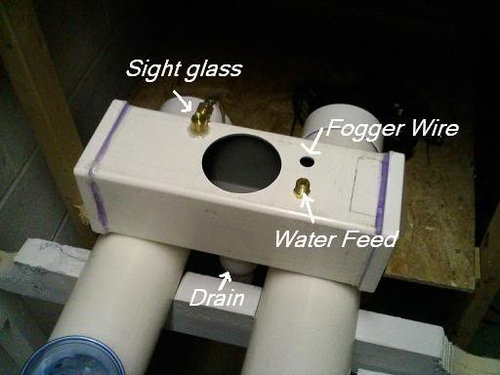Hydro/Aeroponic woes
eviloatmeal
14 years ago
More Discussions
I have a few questions about those with successful hydro/aero setups. I want to fun foggers only, without actual liquid. My problem is I cannot seem to figure out HOW to make the fogger work without water running in with the fog.
I have a 14" piece of PVC fence post, capped on both ends. There are 2 90* 3/4" pipes equidistant in thirds coming out of the bottom of the fogger, and in between those is a drain for excess water. This thing is fed by a 190 gph pump, turned down to about 90 gph. There is a water feed hole, and a hole for the fogger cord, and a 3" hole for me to look into. The fog ports are higher than the drain, by about 2". This is so the fog can flow out of it without water. I have a valve on the drain to regulate how much water is in the unit at any given time, since it's easier to control draining than the incoming flow.
I can post pictures in a few minutes, need to upload them.
For those with successful setups;
Do you run E&F systems with it?
Should I just flood and drain the roots on a timer?
Add a fan to my fogger to push the fog?
How do I keep the fogger in the correct amount of liquid without flooding my pipes or running the fogger without enough liquid?

grizzman
eviloatmealOriginal Author
Related Professionals
Simpsonville Landscape Architects & Landscape Designers · Barrington Hills Landscape Architects & Landscape Designers · Clemson Landscape Architects & Landscape Designers · Ilchester Landscape Architects & Landscape Designers · Salem Landscape Architects & Landscape Designers · Sand Springs Landscape Architects & Landscape Designers · Canton Landscape Contractors · Stamford Landscape Contractors · Concord Landscape Contractors · Farmington Landscape Contractors · Huntington Landscape Contractors · Long Branch Landscape Contractors · Melrose Landscape Contractors · Irvington Landscape Contractors · Bensenville Landscape Contractorslucas_formulas
eviloatmealOriginal Author
lucas_formulas
lucas_formulas
grizzman
eviloatmealOriginal Author
eviloatmealOriginal Author
lucas_formulas
eviloatmealOriginal Author
lucas_formulas
hardclay7a